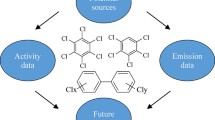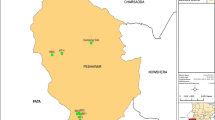Abstract
Pentachloronitrobenzene (PCNB) products have been reported to contain relatively high levels of polychlorinated dibenzo-p-dioxins (PCDDs), polychlorinated dibenzofurans (PCDFs) as impurities. No data was available for Chinese PCNB products which are still produced and used in China. Therefore, we analysed Chinese PCNB products, including two raw pesticides and three formulations available on the market. In all samples, PCDDs, PCDFs, and dioxin-like polychlorinated biphenyls (DL-PCBs) were detected at levels exceeding Japanese regulation limits. The concentrations of PCDDs and PCDFs (0.16 to 0.93 ng TEQ g−1) were lower than the PCNB formulations measured from the Australian market (3.9 ng TEQ g−1). However, the Toxic Equivalent (TEQ) contribution from DL-PCBs (0.7 to 2.5 ng TEQ g−1) to total TEQ was higher compared to PCDDs and PCDFs. This discovery demonstrated that it is necessary to consider the DL-PCBs impurity in organochlorine pesticides and other organochlorine chemicals in particular chlorinated aromatic compounds for adequate risk assessment. In addition to DL-PCBs, other unintentionally POPs—hexachlorobenzene (HCB) (3.7 to 52 ng g−1) and pentachlorobenzene (PeCBz) (0.04 to 0.3 ng g−1) which are listed in the Stockholm Convention—were detected in the PCNB samples. The PCNB production steps were assessed for their unintentional POPs formation potential. Thermolysis of the aromatic compounds using iron chloride (FeCl3) as catalyst is suggested as relevant production step for (DL-)PCBs formation. Since the levels in the formulated PCNB recalculated to active ingredient were higher compared to the raw pesticide, the formulation process (e.g., milling) may also have had an influence on additional PCDD/Fs and PCBs formation.



Similar content being viewed by others
References
Ambrus A, Hamilton D, Kuiper H, Racke K (2003) Significance of impurities in the safety evaluation of crop protection products (IUPAC technical report). Pure Appl Chem 75:937–973
Anezaki K, Nakano T (2014) Concentration levels and congener profiles of polychlorinated biphenyls, pentachlorobenzene, and hexachlorobenzene in commercial pigments. Environ Sci Pollut Res Int 21:998–1009
APVMA (2010) Suspension of quintozene active constituent approvals, products containing quintozene and label approvals of products containing quintozene. Australian Pesticides and Veterinary Medicines Authority
APVMA (2011) Continued suspension of quintozene active constituent approvals, products containing quintozene and label approvals of products containing quintozene. Australian Pesticides and Veterinary Medicines Authority
Chen K, Wojtalewicz D, Altarawneh M, Mackie JC, Kennedy EM, Dlugogorski BZ (2011) Formation of polychlorinated dibenzo-p-dioxins and dibenzofurans (PCDD/F) in oxidation of captan pesticide. Proc Combust Inst 33:701–708
China Pesticide Information Network. http://www.chinapesticide.gov.cn/. Accessed on March 25, 2014
Coats JR, Yamamoto H (2003) Environmental fate and effects of pesticides American Chemical Society Washington, D.C.
Dorrepaal W, Louw R (1978) The mechanism of the vapor-phase chlorination of benzene derivatives. In J Chem Kinet 10:249–275
EHC41 (1984) Environmental Health Criteria for Quintozene. http://www.inchem.org/documents/ehc/ehc/ehc41.htm. Accessed 24 March 2014
EPA (2006) Reregistration eligibility decision for pentachloronitrobenzene. United States Environmental Protection Agency
ERMA (2010) Environmental Risk Management Authority decision on grounds for reassessment of a substance. ERMA 200648 Environmental Risk Management Authority of New Zealand
ERMA (2011) Environmental Risk Management Authority Decision. Application for the reassessment of: Water dispersible granule or wettable powder containing 750 g/kg quintozene. ERMA200692 Environmental Risk Management Authority of New Zealand
Fantke P, Friedrich R, Jolliet O (2012) Health impact and damage cost assessment of pesticides in Europe. Environ Int 49:9–17
Goetz R, Sokollek V, Weber R (2013) The dioxin/POPs legacy of pesticide production in Hamburg: part 2—waste deposits and remediation of Georgswerder landfill. Environ Sci Pollut Res Int 20:1925–1936
Hamilton D, Crossley S (2004) Pesticide residues in food and drinking water: human exposure and risks. Wiley, West Sussex
Holt E, Vetter W, Symons R, Stevenson G, Weber R, Gaus C (2009) Assessing pesticides as a source of dioxins to the Australian environment. 29th International Symposium on Halogenated Persistent Organic Pollutants August 23–28, 2009, Beijing, China. Organohalogen Compounds 71:292–295
Holt E, Weber R, Stevenson G, Gaus C (2010) Polychlorinated dibenzo-p-dioxins and dibenzofurans (PCDD/Fs) impurities in pesticides: a neglected source of contemporary relevance. Environ Sci Technol 44:5409–5415
Holt E, Weber R, Stevenson G, Gaus C (2012) Formation of dioxins during exposure of pesticide formulations to sunlight. Chemosphere 88:364–370
Horiguchi T, Oooka Y, Kobayashi S, Hongou K (2007) Sound disposal of PCNB pesticide in an industrial waste incineration facility. Proc Ann Conf Jpn Soc Waste Manag Experts 18:303–305 (in Japanese)
Hu D, Hornbuckle KC (2010) Inadvertent polychlorinated biphenyls in commercial paint pigments. Environ Sci Technol 44:2822–2827
Huang J, Matsumura T, Yu G, Deng S, Yamauchi M, Yamazaki N, Weber R (2011) Determination of PCBs, PCDDs and PCDFs in insulating oil samples from stored Chinese electrical capacitors by HRGC/HRMS. Chemosphere 85:239–246
Li R, Zheng J-W, Ni B, Chen K, Yang X-J, Li S-P, Jiang J-D (2011) Biodegradation of pentachloronitrobenzene by Labrys portucalensis PCNB-21 isolated from polluted soil. Pedosphere 21:31–36
Liu P-Y, Zheng M-H, Zhang B, Xu X-B (2001) Mechanism of PCBs formation from the pyrolysis of chlorobenzenes. Chemosphere 43:783–785
Liu W, Zheng M, Wang D, Xing Y, Zhao X, Ma X, Qian Y (2004) Formation of PCDD/Fs and PCBs in the process of production of 1, 4-dichlorobenzene. Chemosphere 57:1317–1323
MAFF (2002) Results from the survey on the dioxins in pesticides. Department of Production, Ministry of Agriculture, Forestry and Fisheries (MAFF) of Japan. http://warp.ndl.go.jp/info:ndljp/pid/250942/www.maff.go.jp/www/press/cont/20020415press_2.pdf (in Japanese)
Masunaga S, Takasuga T, Nakanishi J (2001) Dioxin and dioxin-like PCB impurities in some Japanese agrochemical formulations. Chemosphere 44:873–885
Masunaga S, Yao Y, Ogura I, Sakurai T, Nakanishi J (2003) Source and behavior analyses of dioxins based on congener-specific information and their application to Tokyo Bay basin. Chemosphere 53:315–324
Sommeling PM, Mulder P, Louw R, Avila DV, Lusztyk J, Ingold KU (1993) Rate of reaction of phenyl radicals with oxygen in solution and in the gas phase. J Phys Chem 97:8361–8364
Stenersen J (2004) Chemical pesticides mode of action and toxicology . CRC Press/Taylor and Francis Group, Boca Raton
Torres JPM, Fróes-Asmus CIR, Weber R, Vijgen JMH (2013) Status of HCH contamination from former pesticide production and formulation in Brazil—A task for Stockholm Convention Implementation. Environ Sci Pollut Res 20:1951–1957
UNEP (2005) Standardized toolkit for identification and quantification of dioxin and furan releases. United Nations Environment Programme Chemicals, Geneva, Switzerland
UNEP (2010) Additional consideration of new persistent organic pollutants: pentachlorobenzene. Persistent Organic Pollutants Review Committee Sixth meeting, Geneva, Switzerland
UNEP (2013) Toolkit for Identification and Quantification of Releases of Dioxins, Furans and Other Unintentional POPs under Article 5 of the Stockholm Convention on Persistent Organic Pollutants. United Nations Environment Programme Chemicals. http://toolkit.pops.int/, Geneva, Switzerland
USEPA (2005) The Inventory of Sources and Environmental Releases of Dioxin-Like Compounds in the United States: The Year 2000 Update (External Review Draft), Chapter 8: Chemical Manufacturing and Processing Sources. http://www.epa.gov/ncea/pdfs/dioxin/2k-update/
Vida P, Moretto A (2007) Pesticide exposure pathways among children of agricultural workers. J Publ Health. 289–299
Wang ZY (2010) To promote the integration of Glyphosate production companies by cancelling the tax drawback for export. AgriGoodsHerald. http://www.nzdb.com.cn/tabid/75/InfoID/12130/Default.aspx. (in Chinese). Accessed 24 March 2014
Weber R, Hagenmaier H (1999) Mechanism of the formation of polychlorinated dibenzo-p-dioxins and dibenzofurans from chlorophenols in gas phase reactions. Chemosphere 38:529–549
Weber R, Varbelow HG (2013) Dioxin/POPs legacy of pesticide production in Hamburg: part 1—securing of the production area. Environ Sci Pollut Res Int 20:1918–1924
Weber R, Gaus C, Tysklind M, Johnston P, Forter M, Hollert H, Heinisch H, Holoubek I, Lloyd-Smith M, Masunaga S, Moccarelli P, Santillo D, Seike N, Symons R, Torres JPM, Verta M, Varbelow G, Vijgen J, Watson A, Costner P, Wölz J, Wycisk P, Zennegg M (2008) Dioxin- and POP-contaminated sites—contemporary and future relevance and challenges: overview on background, aims and scope of the series. Environ Sci Pollut Res Int 15:363–393
Acknowledgments
This research was financially supported by the National High-Tech Research and Development Program (Nos. 2013AA06A305).
Author information
Authors and Affiliations
Corresponding author
Additional information
Responsible editor: Ester Heath
Electronic supplementary material
Below is the link to the electronic supplementary material.
ESM 1
(DOC 1743 kb)
Rights and permissions
About this article
Cite this article
Huang, J., Gao, J., Yu, G. et al. Unintentional formed PCDDs, PCDFs, and DL-PCBs as impurities in Chinese pentachloronitrobenzene products. Environ Sci Pollut Res 22, 14462–14470 (2015). https://doi.org/10.1007/s11356-014-3507-2
Received:
Accepted:
Published:
Issue Date:
DOI: https://doi.org/10.1007/s11356-014-3507-2




